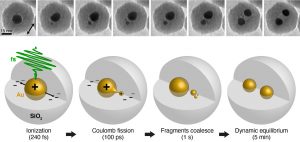The strong absorptions of plasmonic nanoparticles provide a convenient means to reshape them through pulsed laser irradiation and thus tune their properties. This has given rise to an entire field of research that investigates and exploits a range of mechanisms for laser-particle reshaping. At low laser fluence, shape transformations are induced through melting and subsequent resolidification of the particles. If higher fluences are employed to heat the particles beyond their boiling point, size reduction occurs through surface evaporation. Fragmentation can be achieved when intense ultrafast laser pulses are used to ionize the nanoparticles. Despite numerous experimental and theoretical studies, the exact mechanism of ultrafast laser-induced fragmentation has long been debated.

Our group uses in situ transmission electron microscopy to directly observe femtosecond laser-induced fragmentation of plasmonic nanoparticles. Our experiments reveal that gold nanoparticles encased in a silica shell fragment by emitting small progeny droplets comprised of about 100 atoms. We find that droplets are ejected along the laser polarization direction (black arrow). These observations suggest that the fragmentation mechanism involves Coulomb fission, which occurs as femtosecond laser pulses ionize and melt the nanoparticles, causing them to eject highly charged progeny droplets.
Related publications:
The Fragmentation Mechanism of Gold Nanoparticles in Water Under Femtosecond Laser Irradiation
G. Bongiovanni, P.K. Olshin, C. Yan, J.M. Voss, M. Drabbels, U.J. Lorenz. Nanoscale Adv. 3, 5277–5283 (2021)
In Situ Observation of Coulomb Fission of Individual Plasmonic Nanoparticles
J.M. Voss, P.K. Olshin, R. Charbonnier, M. Drabbels, U.J. Lorenz. ACS Nano 13, 12445–12451 (2019)